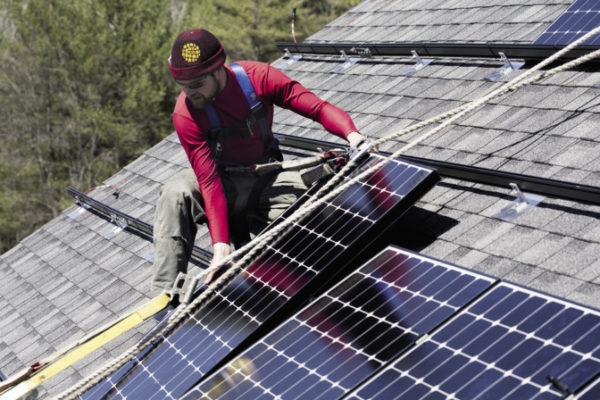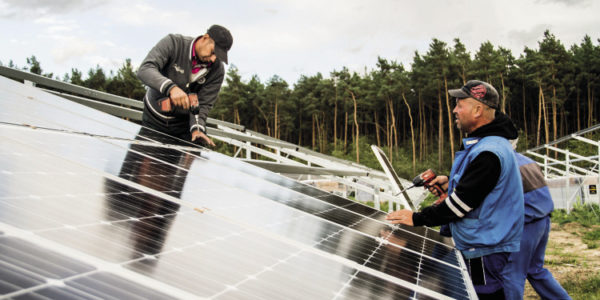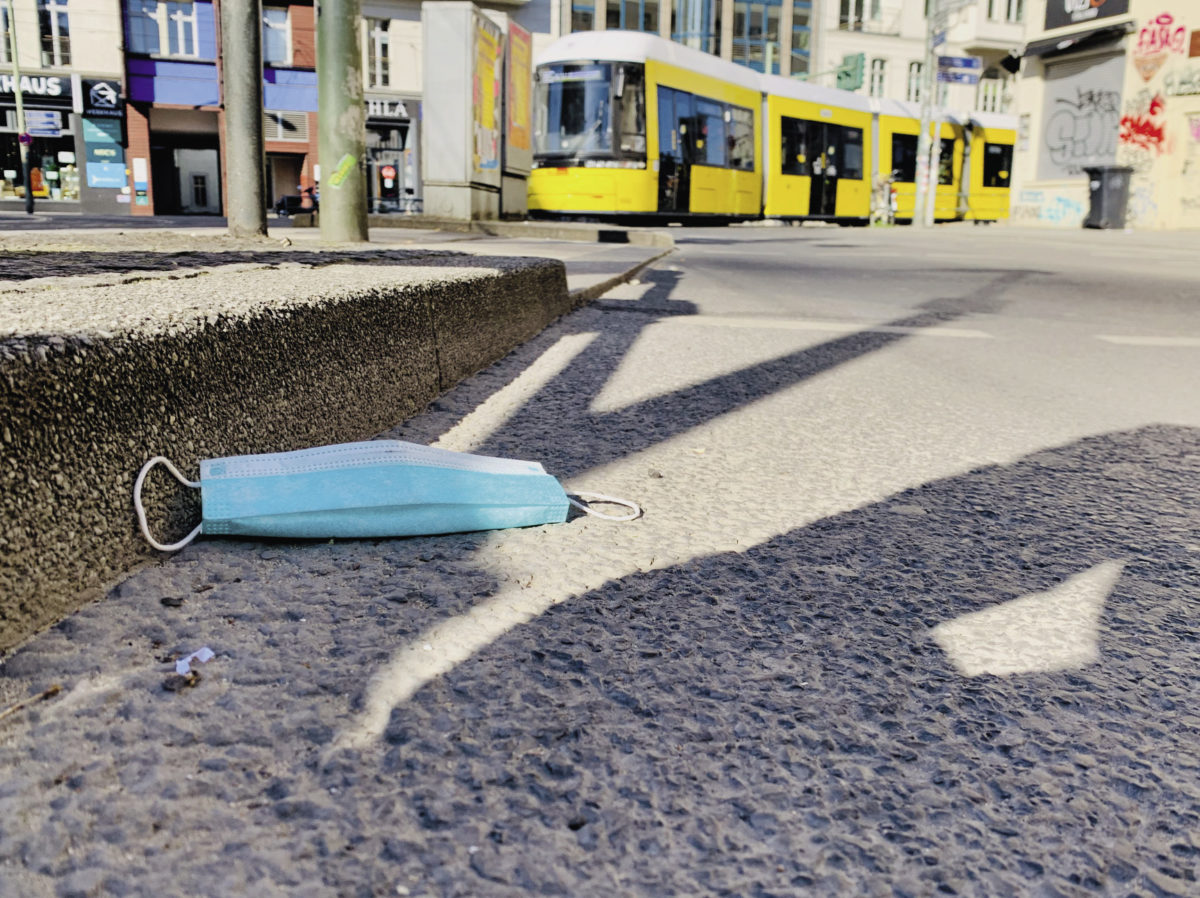From pv magazine 04/2020
For the PV industry, accustomed as it is to growth, it is near impossible to predict what impact the shock delivered by Covid-19 and the shutdowns employed to limit its spread will have. On March 13, BloombergNEF announced that it was downwardly revising its forecast for new installed capacity from its initial figures of between 121-152 GW to 108-143 GW. The former forecast had only been made in February.
Notably, the pessimistic end of the revised forecast represents an annual decline in solar installations – the first of its kind, at least in this century.
“Our forecast encompasses both a rise and fall of the solar market [year on year],” says Jenny Chase, the head of BloombergNEF’s Solar Insight team. “Which is hedging our bets a bit, but we cut both of our forecasts.” Chase says that while it’s difficult “to know exactly” what the impact of Covid-19 will be, the large-scale segment will likely see some committed projects pushed back to 2021.
Developers and suppliers, Chase reports, are claiming Covid-19 represents a “Force Majeure event” – meaning that delivery and competition deadlines are forgiven. “I think this is quite healthy,” says Chase, although it will impact installation rates for 2020. She notes that one developer in the United States invoked Force Majeure on the basis of being unable to feed its workers – due to all local restaurants being closed.
The commercial rooftop PV segment may be largely unaffected this year, the BloombergNEF analyst reports. But C&I companies may bear the full brunt of the viral downturn in 2021.
“It is probably not that bad, because most of the commercial rooftop systems were already lined up for this,” says Chase. “In 2021 it will be worse hit, because the pipeline will suffer … doing commercial businesses takes many people to sign off on a project, meaning that the pipeline will dry up.”
On the upside, Chase notes that installing solar requires little physical contact, so is generally a “low risk” workplace activity in the Covid-19-impacted workplace. As economies in key solar markets like the United States and Europe begin to reopen for business, it is likely that PV installations could resume. “It strikes me that it [PV] could be one of the things to be eased up at an early stage,” says Chase.
Stimulus support
There does exist the chance that various stimulus measures introduced by national or even regional governments could be directed the way of solar. Already, there is talk an extension to the U.S. Investment Tax Credit could be bundled into a raft of stimulus measures. In Australia, an expansion of immediate tax writedowns for businesses on capital investment, including rooftop PV and battery storage, appears to be delivering a positive signal. And government spending programs potentially funding the installation of rooftop solar on schools and other public buildings could provide a boost in many solar markets.
On the residential side, currently there are mixed reports coming from the installers. Household budgets will undoubtedly be stressed, and there are reports of cancellations coming from retailers. However, very low interest rates could incentivize “zero-up-front” solar loans – delivering the dual payoff of keeping cash in the pockets of the homeowner, and reducing their home office costs, in the form of electricity bills.
For the “preppers” – those looking to secure sufficient supplies of essentials – a solar+storage system could deliver peace of mind. Indeed, electricity may be the new toilet paper – despite there being few signals that electricity supplies are set to be disrupted.
China, as always a central player in the global solar industry, presents an example of hope. Increasingly, there are signs that a degree of normality is returning – some three months after the more drastic containment measures were put in place. Projects are delayed, but signs are that activity on the supply side is returning to normal.
As it will for the wider economy, Covid-19 will likely cause businesses to reflect inwardly on what their core mission is and jobs will undoubtedly be lost, along with the opportunity for ongoing market expansion in the short term. Fortuitously for solar businesses, instability and sudden shocks are the norm in this young sector. As one veteran put it: “This isn’t my first ride on the solarcoaster.”
Jonathan Gifford
PV steps up to the plate
Some solar and battery storage manufacturers are going beyond protecting their own businesses and are making contributions to tackle the Covid-19 pandemic head on. Chinese manufacturer BYD announced in early March that it had established a factory to produce 5 million face masks and 300,000 bottles of disinfectant per day. Tesla’s Elon Musk, despite having previously sent some mixed signals about the severity of the global pandemic, acquired 1,255 ventilators from China, shipped them to California and has teams working with officials on their installation.
U.S. residential faces trouble over the next few quarters
The U.S. coronavirus emergency stimulus package could contain an extension of tax deadlines for solar, but as of the time of press deadline, the U.S. congress and the Trump administration had not reached agreement on the details of the $2 trillion bill. Stocks bounced higher in anticipation of the deal being signed.
The Democrats have little leverage, but the members of these deliberative bodies must vote by unanimous consent if they are not physically in the nation’s capital – and they are not.
The Solar Energy Industries Association (SEIA) is warning that the impact from the coronavirus could cut the solar industry’s headcount in half. SEIA is trying to push Congress to make the solar federal tax credit payable directly to customers.
Popular content
Solar installers in the U.S. are already feeling the pain of the measures taken to slow the virus. “The impact of Covid-19 on our business is becoming increasingly severe. Over the past month we’ve gone from sanitizers and hand wipes (three weeks ago), to social distancing with only one person per vehicle (last week), to a partial shutdown as customers cancel or postpone their projects. I expect this situation will get even worse over the next month,” noted Barry Cinnamon of Cinnamon Energy Systems.

Image: Sungevity
He added, “Customers are canceling because they are worried about their financial portfolios, and also want to maintain social distancing. From a portfolio standpoint, we remind customers that solar is just about the best investment they can make in these uncertain times.”
Vendors close to the installer market are being affected. The HR lead at Shoals Technologies Group noted that the solar hardware provider plans “to fully compensate ALL of our employees in the event we need to shut down operations due to Covid-19. This plan will positively impact over 600 people who are paid an hourly wage.”
Roth Capital Partners reports that “some U.S. installers are now seeing a 30% cancellation or postponement of bookings, and the sales funnel is drying up.” Despite the momentum in U.S. residential solar, Roth speculates that U.S. residential demand “could be meaningfully impacted to the downside.”
Roth expects Q2 to be very weak, ”though some believe we could see a strong recovery in Q3,” as well as “a potential oversupply” as production ramps-up and global demand potentially slows.
Cinnamon notes, “Nevertheless, I expect almost all businesses to prepare for a few months of hibernation – no one really knows how this situation will evolve. I also hope that the federal government will pass legislation that will support both hourly and salary workers who are subject to the inevitable work slowdowns.”
Eric Wesoff
Weak dollar adds insult to injury Down Under
Before the Covid-19 outbreak changed the way we interact and do business, Australia’s rooftop PV segment was in robust health and looked set to achieve a world-beating 3 GW in 2020. While installation numbers in January and February were 30% up on the same months last year, mixed reports are now coming from different corners of the market.
Wholesalers have been reassuring customers about their access to stock, but for now, supply appears to remain somewhat limited. Industry players have been talking about two to eight-week delays in supply. Yet, the impact of the outbreak seems to be rather individual – some companies have reported an unprecedented surge in sales and inquiries, while some are saying the phones have stopped ringing.
Installations are still going ahead. Some companies have seen requests for projects to be done before a full lockdown occurs or before price increases hit them. The Covid-19 outbreak coincides with the slide of the Australian dollar, which plunged mid-March to its lowest level since 2002, hailing increases in module and inverter prices for the Australian consumer.
On the positive side, the Government has announced that businesses investments up to $150,000 can be instantly written off on tax. This could be a useful lever to drive uptake of C&I rooftop PV in the months to come.
Marija Maisch
Message from the German installers
In most of Germany, PV systems can still be installed, despite recent actions to flatten the growth of Covid-19. These actions mandate that people stay at home and not congregate in groups greater than two. But unlike some European countries people can still go to work. Accordingly, ten days after the German lockdown, it is still legal to install PV systems. As Christian Kearsley, sales head at installer Solarkönig, notes, “at a single family home installation we arrive with two people.” Up to now the company has not experienced problems when installers arrive. And new orders are still coming in.
But as Kearsley clarifies, these are mainly customers who had been in touch with Solarkönig before the crisis and are moving ahead as spring has arrived and the sun shines longer. Sales are also happening on the phone and in theory this way of interacting could be applied to the entire customer acquisition phase during this time of crisis. Solarkönig generates residential leads mainly online and through social media. But at the end of the day, according to Kearsley, “it is difficult to predict where this trip will end.”

Image: SolarWorld
That’s the situation at present. A survey taken during a pv magazine webinar on March 25 yielded a mixed picture. One participant said: “We are still working in the construction sites, but customer appointments are currently handled only by email or telephone.” Another added: “There are considerably fewer orders, since customers do not want to see people outside [their home].” Another issue is the lack of subcontractors for carrying out installations, since many of these employ people from central and eastern Europe, who can no longer enter Germany. Another issue heard frequently is that utilities are limiting their work and no longer installing electricity meters. This would further delay the grid connection of newly installed PV systems.
Michael Fuhs
This content is protected by copyright and may not be reused. If you want to cooperate with us and would like to reuse some of our content, please contact: editors@pv-magazine.com.


2 comments
By submitting this form you agree to pv magazine using your data for the purposes of publishing your comment.
Your personal data will only be disclosed or otherwise transmitted to third parties for the purposes of spam filtering or if this is necessary for technical maintenance of the website. Any other transfer to third parties will not take place unless this is justified on the basis of applicable data protection regulations or if pv magazine is legally obliged to do so.
You may revoke this consent at any time with effect for the future, in which case your personal data will be deleted immediately. Otherwise, your data will be deleted if pv magazine has processed your request or the purpose of data storage is fulfilled.
Further information on data privacy can be found in our Data Protection Policy.